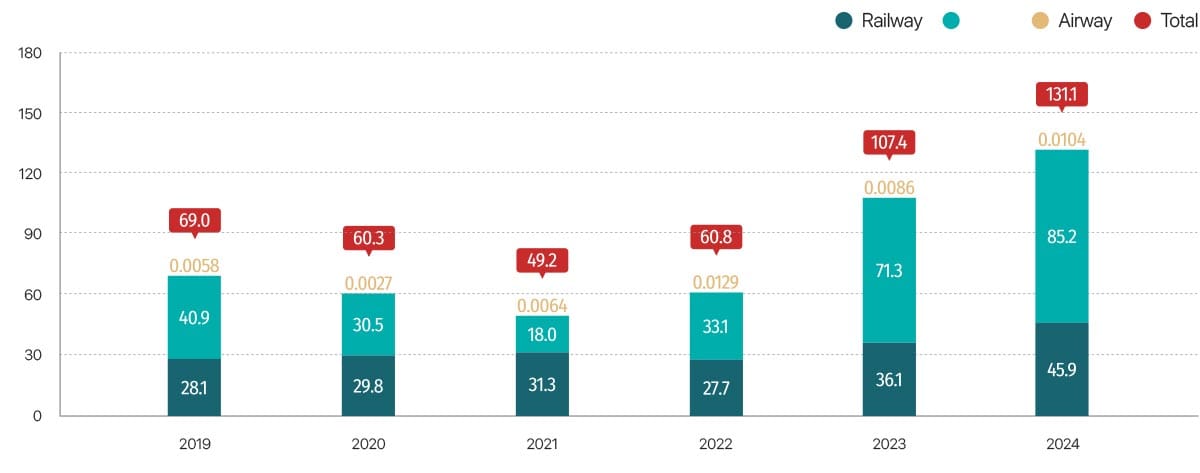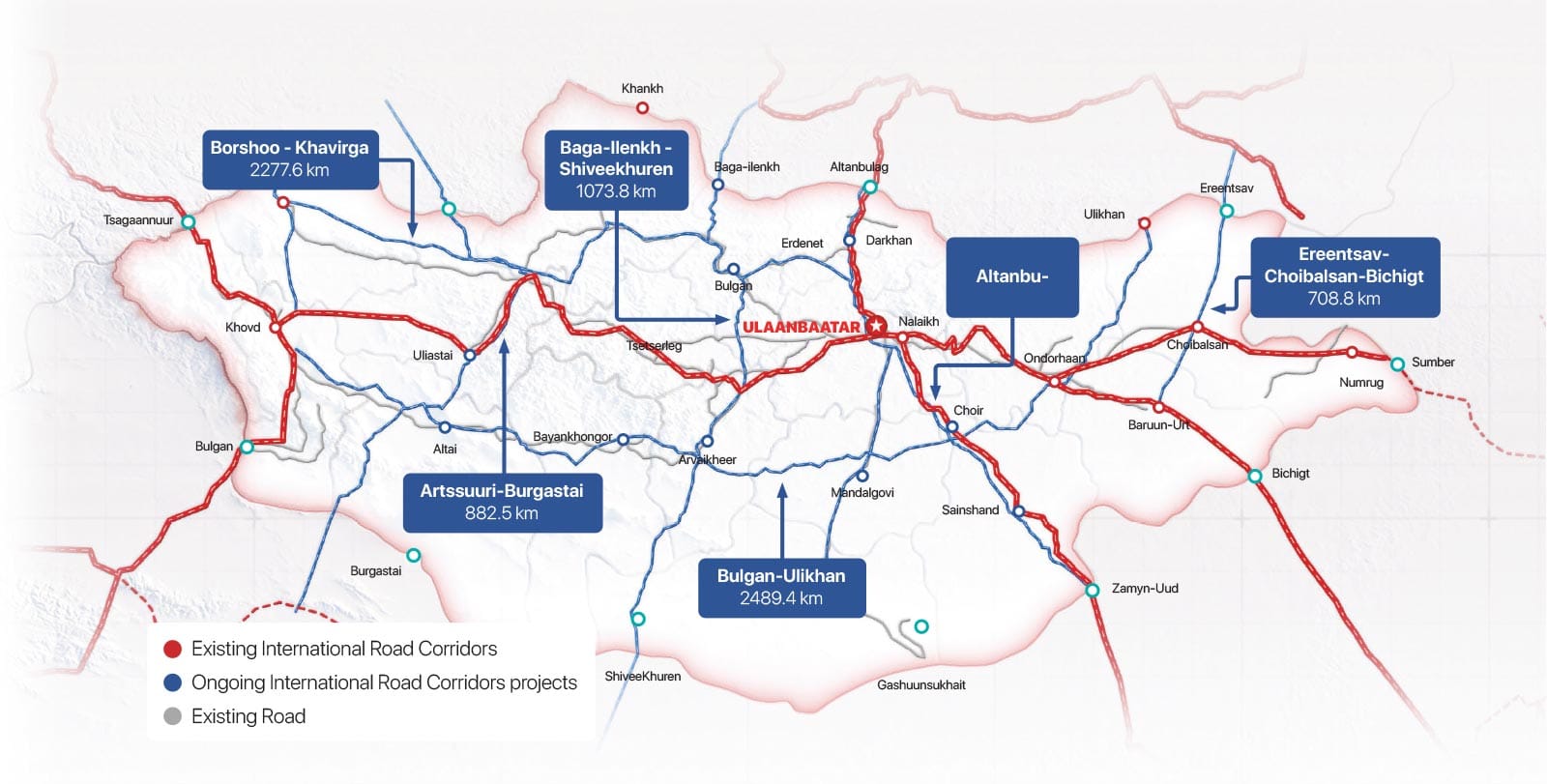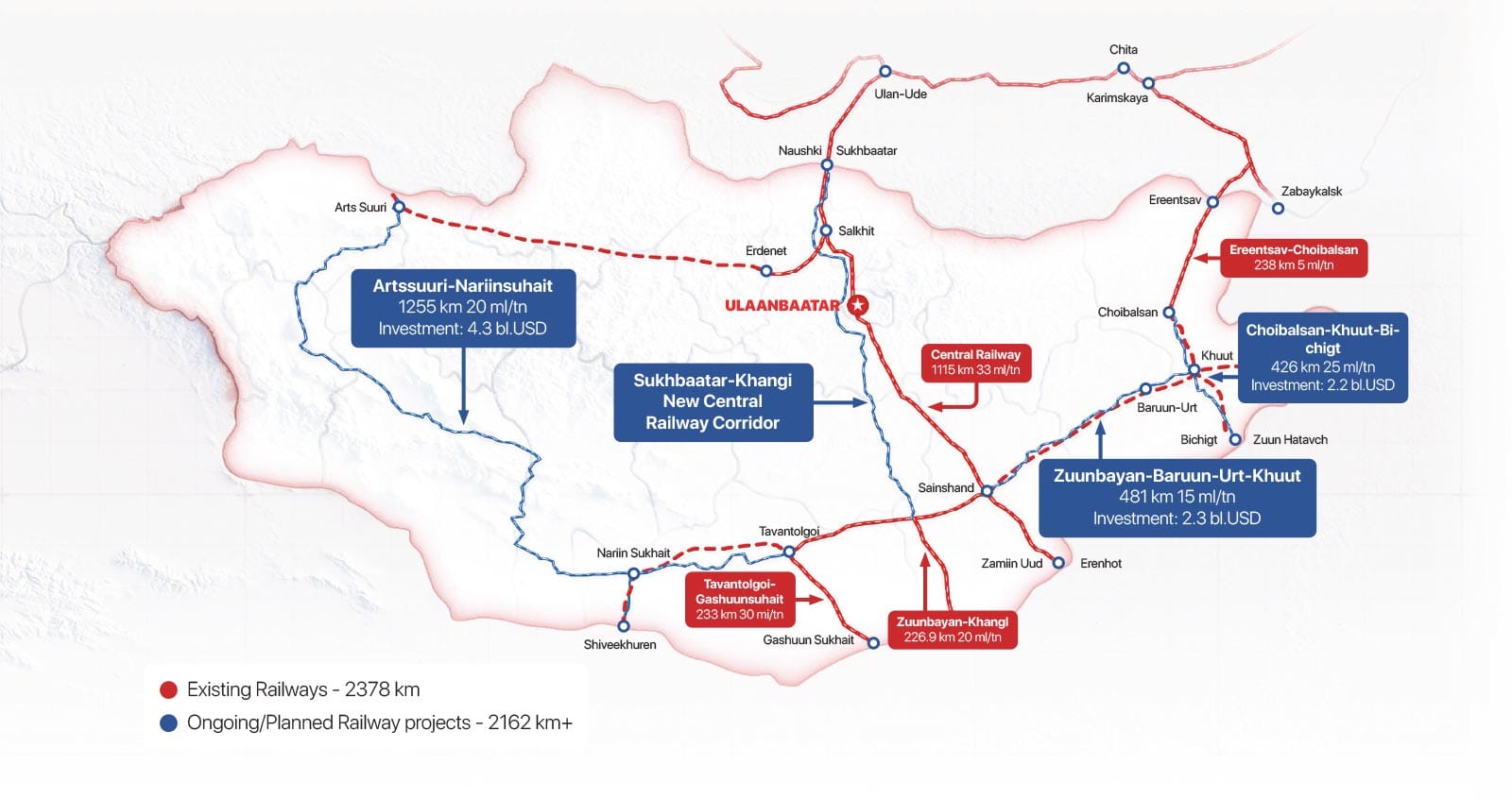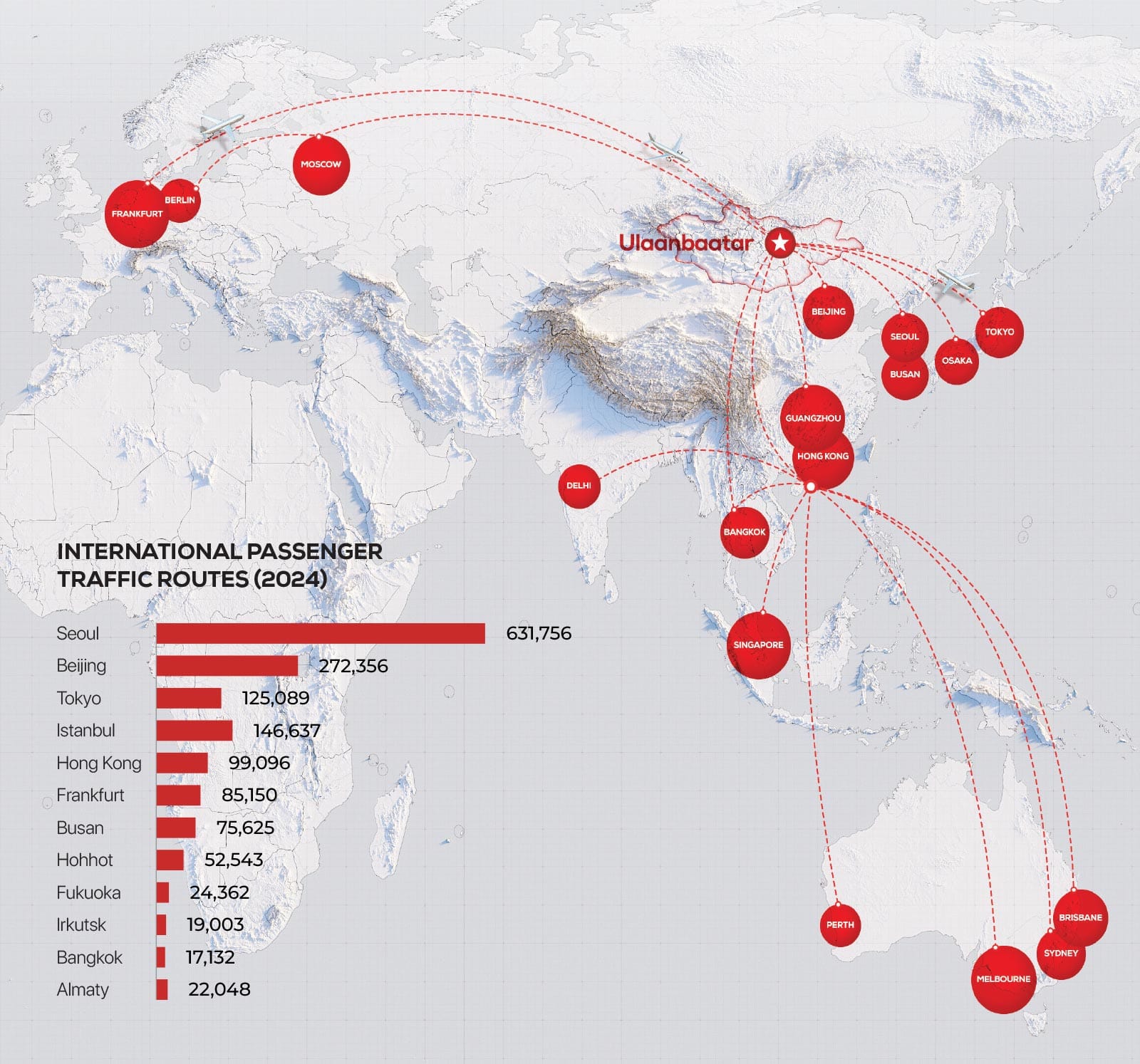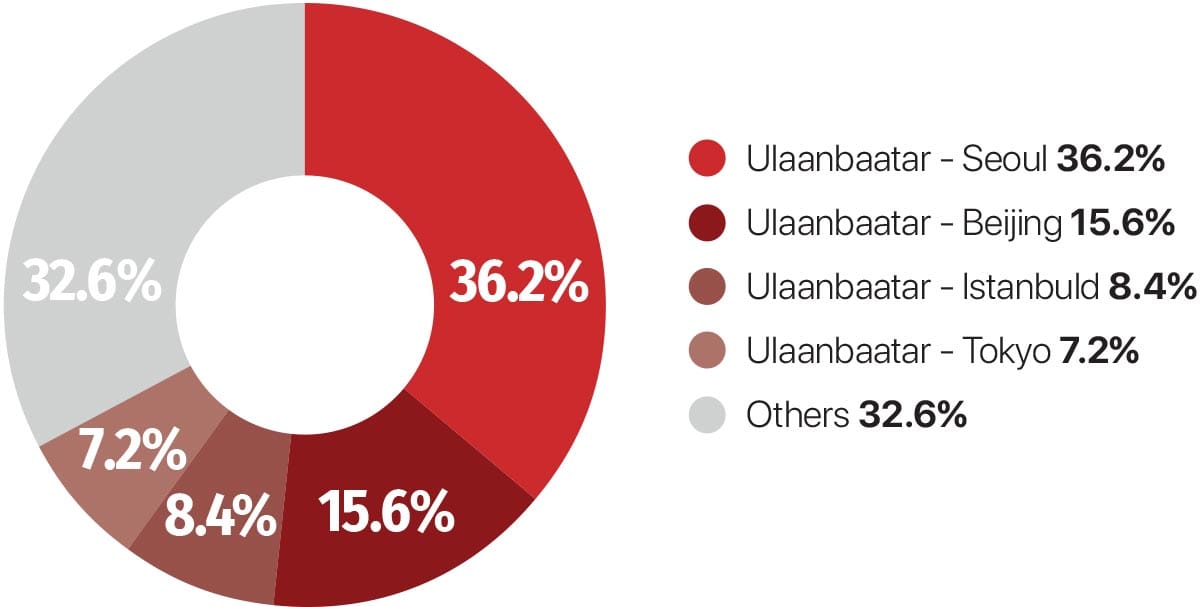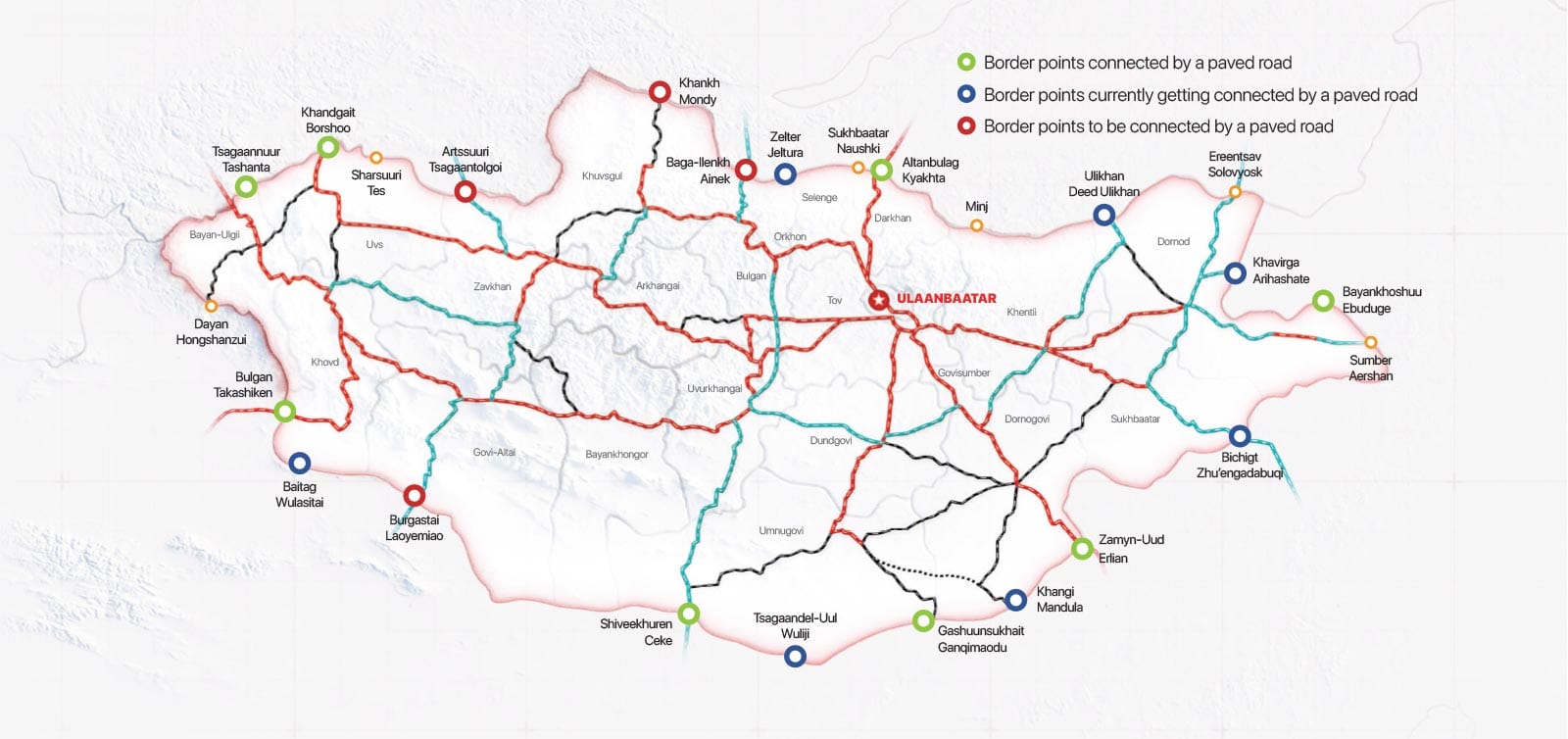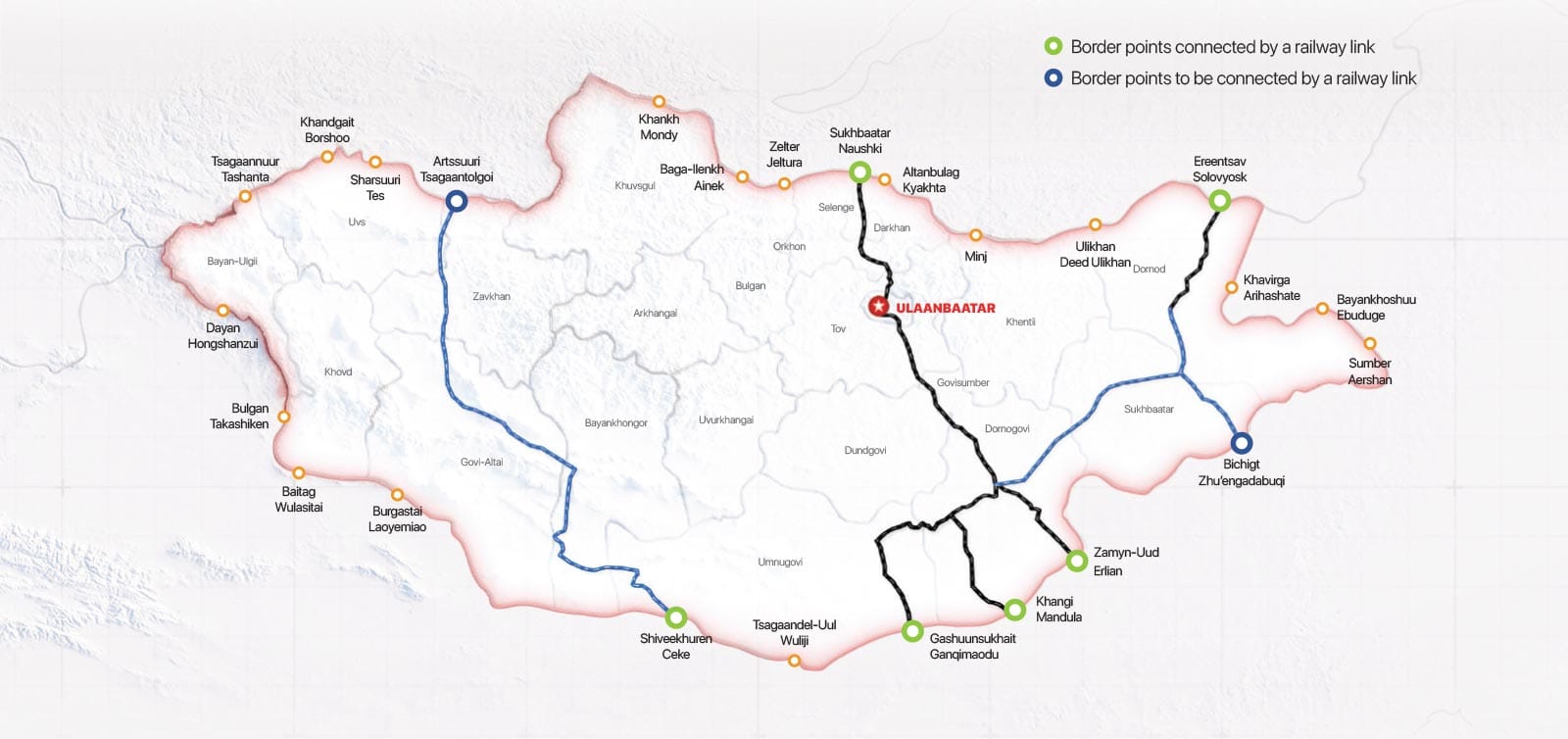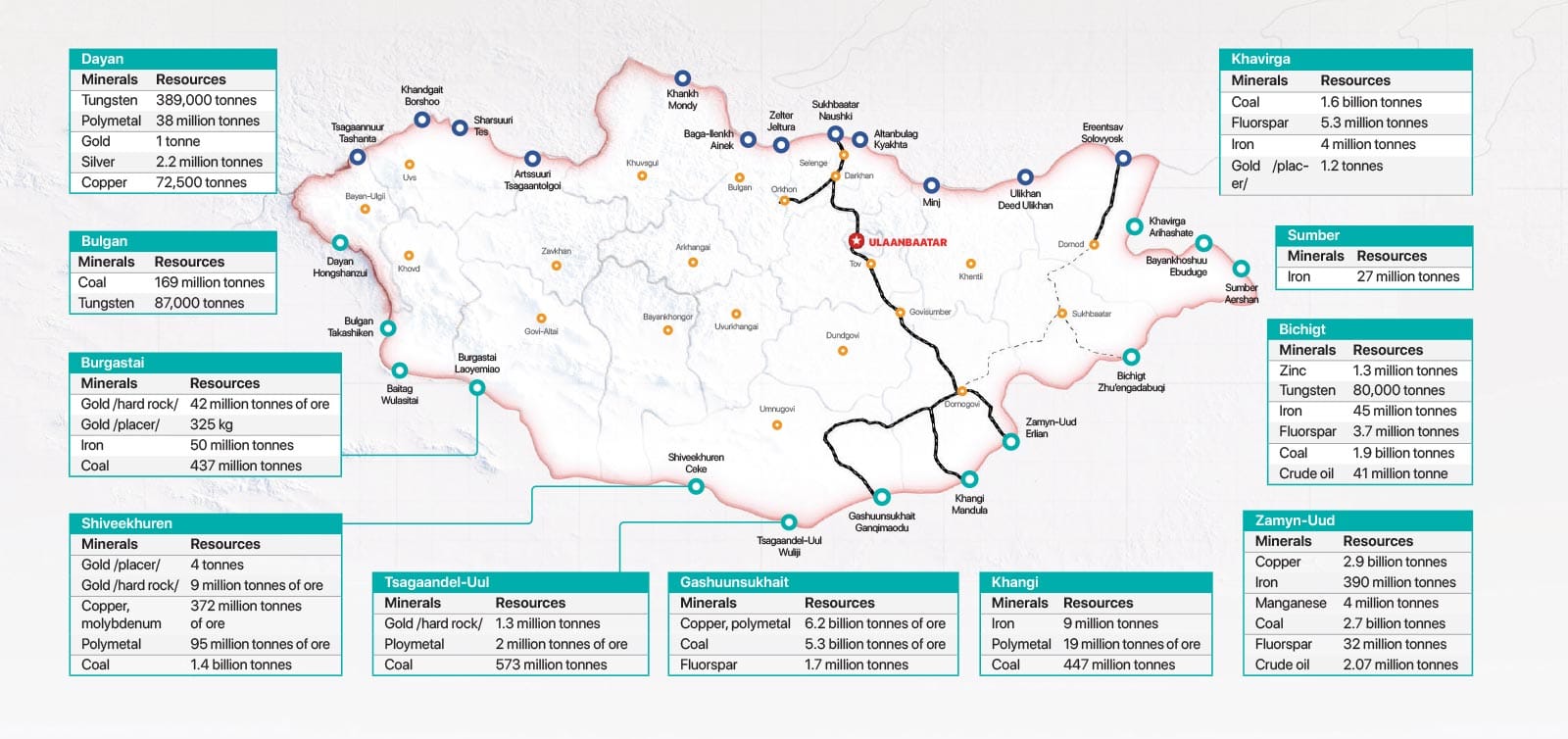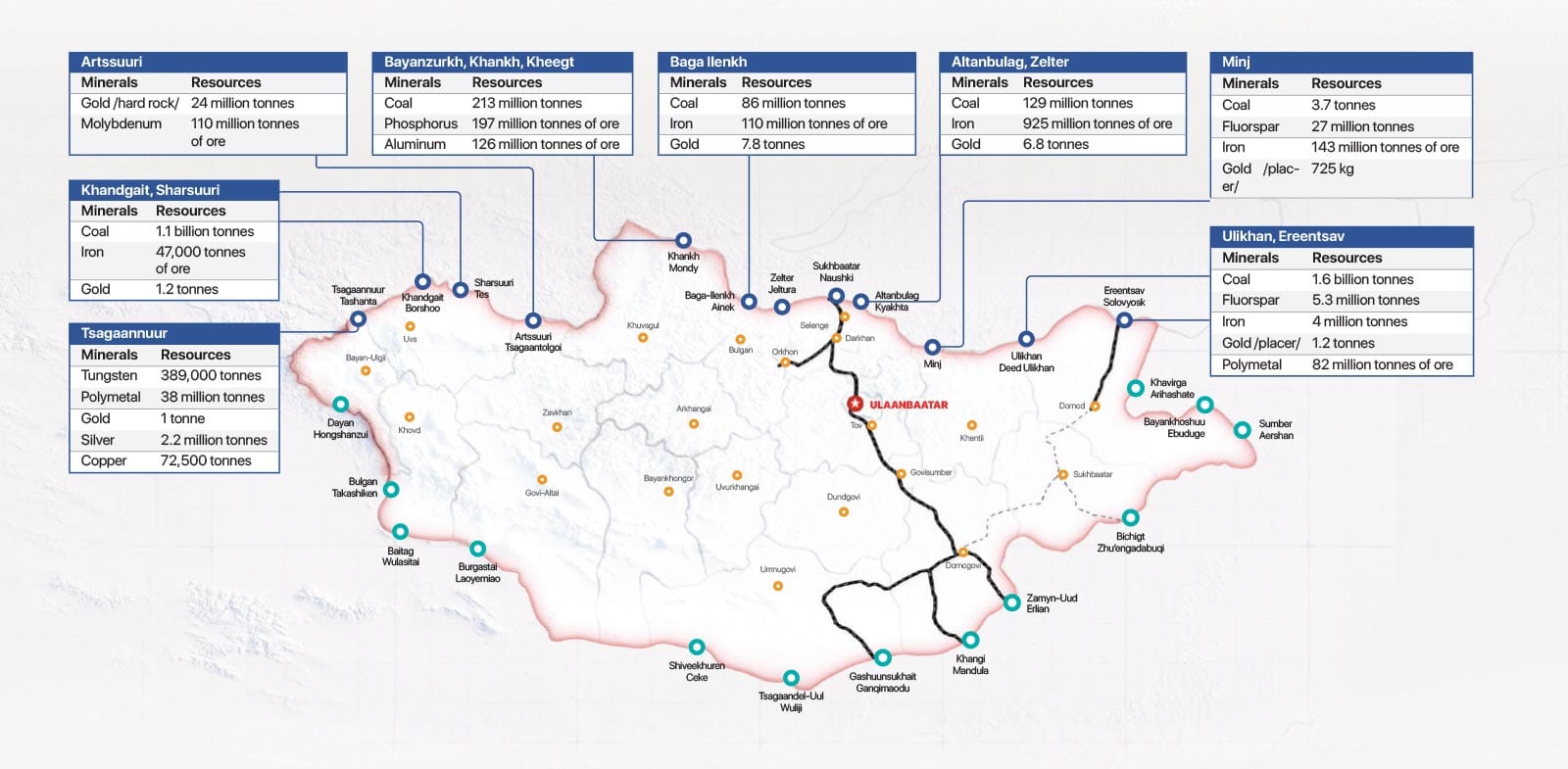Mongolia shares borders with two large neighbors, Russia to the north and China to the south, and is a landlocked country. Mongolia sees opportunity from this unique geographical position to become a trade and transportation transit hub connecting Asia and Europe. In this regard, the development of road and rail infrastructure is of crucial importance. Additionally, in the aviation sector, Mongolia has direct flights connecting major financial hubs in Asia, and efforts are being made to establish international airports at key transit cargo transport hubs to enhance this direction.
TOTAL FREIGHT VOLUME BY TRANSPORT MODE IN MONGOLIA (MILLION TONS)
Source: National Statistics Office and Ministry of Road and Transport of Mongolia
Road
Mongolia boasts a total road network of 112,500 km, comprising 14,921.3 km of international and national standard roads, 96,700 km of local roads, and 898.4 km of special-purpose roads designed for mining commodity transport.
21 provinces and 104 soums had been connected to the capital by paved roads, and 7 ports bordering Russia and China are also accessible via paved roads. The development of the country’s road infrastructure has accelerated in the last decade, with the road network doubling over this period.
Mongolia aims to expand its road network connecting regions, leveraging its geographical advantage of being situated between Asia and Europe. Since 1993, Mongolia has entered into intergovernmental agreements on international road transport with countries such as Russia, China, Kazakhstan, Ukraine, North Korea, Turkey, Kyrgyzstan, Belarus, and Latvia, with the goal of developing international road transport and trade.
The country’s economy is heavily reliant on foreign trade and investment with its two major neighbors, Russia and China. Additionally, as a landlocked nation, the development of a dry land transport network has become one of its key priorities.
Three routes from the Asian Highway Network - AH-3, AH-4, and AH-32 - pass through Mongolia:
- AN-3: Spanning over 1,000 kilometers, this corridor serves as the main route for Mongolia’s export, import, and transit freight transport. In 2023, the 204-km Ulaanbaatar-Darkhan section, part of the AN-3, was upgraded to a two-way, four-lane road and fully opened to traffic. The government aims to extend this upgrade to the remaining sections, transforming the entire route into a two-way, four-lane highway.
- AN-4: The 757.1-km AN-4 route, running through Mongolia’s western region, was completed in 2022. It opened as the second corridor connecting Asia and Europe, with international transportation commencing in 2023.
- AN-32: The AN-32 route, also known as CAREC 4C, is nearing completion, with its connection to the Asian Highway Network fully paved. CAREC 4C is a vital transport corridor within the Central Asia Regional Economic Cooperation (CAREC) program, connecting Russia, Kazakhstan, Kyrgyzstan, China, and Mongolia. This corridor facilitates trade and transport across these countries and is integral to Mongolia’s role as a transit hub between Asia and Europe within the Asian Highway Network.
According to Delgersaikhan Borkhuu, Minister of Road and Transportation of Mongolia, the country plans to connect five vertical corridors and three horizontal corridors linking Asia and Europe entirely with paved roads, thereby expanding opportunities for transit freight and the transportation of domestic export goods.
Mongolia also joined China’s Belt and Road Initiative, a global effort to develop infrastructure connecting Asia and Europe, which includes the creation of a tripartite economic corridor linking China, Mongolia, and Russia, officially approved by three countries in 2016.
Furthermore, preparations have begun for new road projects aimed at supporting commodity exports in the Umnugovi province, home to major mineral deposits. A total of 2,120.9 km of new roads is expected to be constructed in 2025. Of these, 1,079.7 km will connect provinces to one another, 708.6 km will link provinces to ports, and 332.6 km will be dedicated to tourism development.
Asian Highway Infrastructure Connection in Mongolia
Source: Ministry of Road and Transport of Mongolia, 2024
RAILWAY
“Mongolia, in its long-term development policy “Vision – 2050”, aims to leverage its geographical advantage of being situated between Asia and Europe to become a transportation and trade hub – “Transit Nation.” The country aspires to play an active role in the region, with the railway sector playing a critical role in achieving this goal.
Over the past four years, the length of the main railway lines has increased by 935.1 km, the branch railway lines by 204.2 km, and the total length by 1,139.3 km.
As a result, the total length of Mongolia’s railway network reached 3,368.8 km, of which the main railway lines account for 2,420.1 km and the branch lines for 948.7 km.
As part of railway network expansion, in 2021, a 16.3 km loading loop railway at Tavantolgoi was built and commissioned. In 2022, trial transportation began on the 14.3 km double-track railway between Zamiin-Uud and Shargiin-Ovoo, and it was put into operation.
Also in 2022, the 416 km (extended length 462.5 km) Tavantolgoi–Zuunbayan railway, the 233.6 km (extended length 312.9 km) Tavantolgoi–Gashuunsukhait railway, and the 21.1 km (extended length 27.3 km) connecting railway between Tavantolgoi–Gashuunsukhait and Tavantolgoi–Zuunbayan were constructed, trial transportation began, and they were all commissioned for permanent operation in 2023.
Tavantolgoi–Zuunbayan route is expected to have an annual capacity of 15 million tonnes of freight with the potential to double. Tavantolgoi–Gashuunsukhait railway has an annual capacity of 30–50 million tonnes of freight transportation.
The construction of the 226.9 km (extended length 286.9 km) Zuunbayan–Khangi railway was completed, and trial transportation began in early 2023. It was commissioned for permanent operation in 2024, and the 7.1 km Shiveekhuren–Ceke railway was also put into operation.
The Zuunbayan–Khangi railway is set to increase the export value of over 10 deposits in the Gobi region. The Shiveekhuren–Ceke railway connection marks the beginning of the western vertical axis Shiveekhuren–Nariinsukhait–Artssuuri railway, a cross-border railway of the “Economic Corridor” of Mongolia, Russia, and China.
However, to fully utilize these railways for freight transport at their full capacity, it is essential to establish cross-border railway connections with China. The government has included the construction of cross-border railways and freight transfer terminals at the Gashuunsukhait–Gantsmod, Khangi–Mandal, and Shiveekhuren–Ceke border points in its action program and is working toward implementation.
Mongolia now has a national railway network operated by six state and private entities that own the railway infrastructure.
Of these, “Ulaanbaatar Railway,” a Mongolian–Russian joint venture, owns 62% or 2,063.2 km; “Mongolian Railway” SOE owns 15% or 495.9 km; “Tavantolgoi Railway” LLC owns 11% or 356.5 km; “Mongolian Trans Line” LLC owns 8% or 286.9 km; “Bold Tumur Eruu Gol” LLC owns 3% or 120 km; and 1% or 27.1 km belongs to the Oil Refinery. In 2024, an additional 19.2 km of extended railway was put into operation.
As of 2024, the railway network connects 8 provinces, 46 soums, and 3 border ports. The Altanbulag–Zamiin-Uud railway is the central economic corridor of Russia, Mongolia, and China and serves as the main infrastructure for transit, export, and import transportation.”
Within the framework of the government’s action program for 2024-2028, the following new railways are planned for construction:
- The Central Corridor Railway, connecting Altanbulag to the Khangi port.
- The Eastern Vertical Railway, linking Ereentsav to the Bichigt port.
- The Western Vertical Railway, from Arts Suuri to Nariin Sukhait and Shiveekhuren.
- The Horizontal Corridor Railway, connecting these routes across the country.
These railway projects aim to further enhance Mongolia’s transportation infrastructure and export capacity.
Trans-Asian Railway Network Connection in Mongolia
Source: Ministry of Road and Transport of Mongolia, 2024
Air transportation
Mongolia recorded 2.2 million air passengers in 2024, marking a 25.2% increase from the previous year. The country has signed intergovernmental Air Transport Agreement with 36 countries, including new agreements in 2024 with the United Kingdom, Northern Ireland, Hungary, and Latvia. As a result, five domestic airlines were granted a total of 132 route designations, covering 57 cities across 26 countries worldwide.
Regions of countries which Mongolia has Air transport agreements as of 2024
Source: Mongolian Civil Aviation Authority
The greatest advantage of Mongolia’s geographical location is the availability of direct, scheduled flights to major Asian financial and tourist hubs, such as Seoul, Tokyo, Hong Kong and Beijing, with flight times of 3-5 hours.
AIRPORTS IN MONGOLIA IN 2024
Source: opendata.gov.mn
Mongolia has one international airport and 16 licensed airports, 10 of which are owned and operated by the Civil Aviation Authority of Mongolia. The Chinggis Khaan International Airport, located 50 km south of Ulaanbaatar, is the largest airport and became operational in 2021. It has the capacity to serve up to 3 million passengers annually and with additional infrastructure, it will be able to handle an estimated increase of 12 million passengers per year. The airport will also feature a 24-hour, all-weather air traffic control system.
Chinggis Khaan International Airport has received the “4 STAR AIRPORT” certification from Skytrax, an international aviation research and audit organization that ranks the services of global airlines and airports. There are 22 four-star and 89 five-star airports in the world, making the airport one of the top 111 airports in the world. At the same time, Chinggis Khaan International Airport set a record in 2024, serving more than two million passengers, which is the largest number in its history.
Only the Chinggis Khaan International Airport handles international flights. Local airports of Murun, Khovd, Dalanzadgad, Choibalsan, and Ulaangom are authorized to receive international flights from 13 countries, including Russia, Turkey, Kazakhstan, and the Czech Republic, under the Air Transport Agreements. However, due to their limited capacity, these local airports have not yet received any international flights.
The Mongolian government has a short-term policy for the aviation sector, called “Flying Without Borders”, which will be in effect until 2025. The policy aims to:
- Renew legislations in the aviation sector
- Strengthen human resources in the sector
- Enhance the capacity of local airports
- Liberation of the aviation sector
- Develop light aircraft flights for general aviation
As part of the Mongolian government’s long-term development policy, “Vision-2050”, local airports in eight provinces (Dornod, Uvs, Bayankhongor, Khovd, Umnugobi, Khuvsgul, Zavkhan, and Uvurkhangai) are planned to increase their capacity and achieve international status.
There is also plan to increase the capacity of local airports within the scope of Mongolia’s regional development policy and achieve 4C and 4D status by 2030. A “4C” runway is one that’s 1,800 meters or more in length and capable of handling an aircraft with a wingspan of up to 36 meters and landing gear that is less than 9 meters between the outside edges of the outermost wheels.
Passenger traffic in Mongolia, in thousands
Source: NSO
Source: Ministry of Road and Transport of Mongolia
As of 2024, a total of 132 route designations were granted to air carriers for 57 cities across 26 countries. Domestic airlines accounted for 78.2% of international passenger transport, operated by five Mongolian carriers.
The United States carrier “United Airlines” announced its plans to operate flights to eight additional destinations in 2025. Specifically, Mongolia is included among these destinations, and United Airlines began operating flights from Tokyo to Ulaanbaatar for the first time on May 1, 2025.
Moreover, the air transport agreement between Mongolia and the United States has been finalized, and both governments are working toward launching direct flights between the two countries.
Border points
Mongolia has a total of 39 border points, of which 24 operate on a regular basis.
The Government of Mongolia is implementing a comprehensive policy called the “Border Revival” strategy to enhance the capacity of its border points. Under this initiative:
- From 2019 to 2025, improvements have been made to border point infrastructure and equipment.
- From 2022 to 2027, road projects are being implemented to develop road-based border points.
- From 2019 to 2026, investments are planned in the aviation sector to expand air border points.
- For rail-based border points, development is planned through public-private partnerships.
Under the framework of the Border Revival Policy, plans are underway to connect 11 border checkpoints by road and 4 by rail. As a result, the government aims to triple the overall capacity of Mongolia’s border points and double the country’s exports.
Key activities under the “Border Revival” measures include:
- 1. Increasing trade turnover in the short term: Focused on Gashuunsukhait, Shiveekhuren, Zamiin-Uud, and Altanbulag border points.
- 2. Developing new routes for mineral exports: Focused on Khangi, Bichigt, and Tsagaandel Uul border points.
- 3. Boosting tourism and trade turnover: Focused on Borshoo, Tsagaannuur, Ulkhan, Sumber, and Khankh border points.
Air Border Points
As of today, Mongolia operates international flights primarily through Chinggis Khaan International Airport. In addition to this, there are plans to designate four more airports with international status.
- Geographic Transit Hubs: The Khovd and Choibalsan airports are being developed to serve as international alternate transit airports for temporary layovers.
- Tourism Development: The Murun and Dalanzadgad airports are being upgraded to international status with the goal of promoting tourism in their respective regions.
These initiatives aim to diversify Mongolia’s air transport capacity and support broader economic and tourism objectives.
Source: Ministry of Road and Transports of Mongolia
Railway border points
Source: Ministry of Road and Transports of Mongolia
Chinggis Khaan International Airport
The Chinggis Khaan International Airport, located 52 km from Ulaanbaatar, became operational in 2021. The airport welcomed more than 2 million passengers in 2024. It has a daily capacity to handle 139 flights or 12,000 passengers, with an annual capacity of 3 million passengers.
Mongolia - China border crossing
Mineral and Crude Oil Reserves Near the Mongolia-China Border Checkpoints
Source: Ministry of Industry and Mineral Resources
The Zamyn-Uud-Erlian Road and Railroad Crossing
The Zamyn-Uud-Erlian border checkpoint is a crucial entry point for both passengers and freight traveling between Mongolia and China. The Zamyn-Uud-Erlian border checkpoint, located 650 km from Ulaanbaatar, is a vital hub for Mongolia-China trade, handling 40% of travelers, 76% of cargo vehicles, and 80% of transit entries. It accounts for 28% of total foreign trade, 42% of imports, and 21% of exports. By Q3 2024, 83% of imported cargo passed through this port. Both nations are prioritizing its capacity expansion to boost bilateral trade.
The expansion project started in 2019, with funding of 233.5 million yuan from China and 30.35 billion tugrug from Mongolia. The newly upgraded Zamyn-Uud-Erlian Road Crossing facility opened in January, 2023 and as part of the “New Revival Policy”, the expansion of the port has been completed in 2024, increasing its capacity by 5 times and reaching international standards. Zamyn-Uud-Erlian Road Crossing facility used to handle 900 passengers and 100 passenger vehicles per hour. Currently it handles 5,000 passengers and 500 passenger vehicles, increasing its capacity to serve 20,000 people per day, and the highway freight section is possible to operate for 24 hours a day.
The Zamyn-Uud-Erlian railway crossing operates in accordance with international railway schedules and is designated as a permanent international port through a bilateral border agreement with China. The Erdenet Mining Corporation and other mining firms export copper concentrate, iron ore, and coal to China via this railway crossing.
Gashuunsukhait-Ganqimaodu
The Gashuunsukhait-Ganqimaodu border checkpoint is the main gateway for exporting copper concentrate of Oyu Tolgoi, one of the largest known copper and gold deposit, and coking coal from Tavantolgoi, the largest coal deposit. Therefore, this is crucial for minerals export.
Gashuunsukhait border checkpoint is located in the Khanbogd soum of Umnugovi province, which is 800 km away from Ulaanbaatar city. The checkpoint borders Bayannuur city of the Inner Mongolian Autonomous Region of China. This is a permanent border crossing for the citizens of both countries. Mining products are transported across the border between Monday and Saturday, 08.00 to 20.00 hours.
Over 50% of coal and over 55% of copper concentrate is exported through Gashuunsukhait.
The construction of the 233.6 km-long railway along the Tavantolgoi–Gashuunsukhait route was completed in 2022. However, the bottleneck at the Mongolian–Chinese border is not yet completed.
Renovation work started in June 2025 and is expected to be completed within 24 months. Once completed, Mongolia’s overall coal export capacity is forecasted to double from the current 83 million tons to 165 million tons, and passenger and freight crossings are also expected to double. Upon becoming operational, the railway will have an annual freight capacity of 30 million tons and reduce current transportation costs by 2–2.5 times. In addition, an internationally accredited customs laboratory will be established as construction work is now underway.
This railway is particularly important for increasing Mongolia’s coal exports to China.
Shiveekhuren-Ceke
Shiveekhuren-Ceke border crossing is the second biggest route for coal export. Since the port is situated in the Umnugovi province, it is the primary port for the export of low-grade coal from Nariinsukhait deposits.
The border is considered as a key hub for China’s “”Belt and Road”” initiative and the China-Mongolia-Russia “”Economic Corridor.”” The report highlights that it has the potential to become a strategic gateway for international trade.
Shiveekhuren-Ceke border crossing is located 955 km from Ulaanbaatar city and is a designated permanent two-way crossing. This is the same as the Gashuunsukhait crossing, allowing the transportation of coal between Monday to Saturday, from 08.00 to 20.00 hours, with a two-hour break between 12.00-14.00 hours.
The Shiveekhuren crossing accounts for over 40% of Mongolia’s coal exports. The total cargo transportation at the Shiveekhuren-Ceke border has exceeded 24 million tonnes, reaching the target for 2024 a month ahead of schedule. Port Authority of China nited that, this is the highest achievement since Ceke port’s operation started.
Additionally, Ceke is the first dry port in China to implement automated control transportation. The introduction of automated guided vehicles (AGVs) and 5G-enabled Unmanned Aerial Vehicles (UAVs) has significantly increased the port’s operational efficiency. Cargo transportation at the port is expected to grow in 2025.
The construction of 6.9 km long railroad connecting Shiveekhuren to Ceke Border Point had been completed in 2024, and the operation is expected to start soon. By the end of 2024, new border infrastructure was commissioned to support the export of mining products, increasing the port’s capacity by 10 million tons. In 2024, 26.5 million tons of coal were exported through this port, with another 26 million tons planned for 2025.
Bulgan-Takashiken
It is located 1,556 km away from Ulaanbaatar city in the Bulgan soum of Khovd province. About 60-200 travelers pass through the port daily. In 2017, an international public transport route was established between the Bulgan soum of Khovd province and the Chinese village of Takashiken. The Government of the two countries are considering to extend daily work hours by two hours to accommodate an additional 20,000 passengers and are planning to provide opportunities for citizens to travel with their private cars. The Mongolia Energy Corporation, which currently operates in the Khushuut Coal Mine in Khovd province, primarily supplies coal to the Chinese market through this port.
Bichigt - Zhu’engadabuqi
Situated in the Erdenetsagaan soum of Sukhbaatar province, 850 km away from Ulaanbaatar city, the Bichigt crossing borders with the Zuunkhatavch crossing on the Chinese side. Under the government-level agreement between Mongolia and the People’s Republic of China, the Bichigt crossing was established as a permanently operational border crossing. A high volume of oil as well as a small amount of fluorspar, iron ore, and lignite are mainly exported through this crossing.
Petrochina Daqing Tamsag LLC, responsible for extracting approximately 95% of the country’s total oil production, utilizes the Bichigt crossing for oil exports. The border has undergone expansion and renovations with the aid of financing from the Asian Development Bank, which is expected to double the freight turnover to $400 million upon completion of the project. Starting from the border checkpoint, other government buildings and passenger and freight roads will be renovated and are planned to start the operation in 2025.
The Mongolian government has plans to construct a 426.6 km railway project along the Choibalsan-Khuut-Bichigt route, with the construction of the 10 km railway along Bichigt-Zuunkhatavch. The feasibility study of the Bichigt-Zuunkhatavch railway has been completed and the commissioning of the railway will mark the beginning of the eastern vertical railway, with the economic significance of transporting 8 million tons of export freight annually.
These railway projects will enable an increase in annual freight transport to 25 million tonnes via the Bichigt crossing.
Bayankhoshuu-Ebuduge
The Bayankhoshuu crossing is under the administration of the Khalkhagol soum of Dornod province, bordering the Uvdug crossing of China.
The border checkpoint is located at a distance of 2.4 km from the actual border, 350 km from Choibalsan, and 1,018 km from Ulaanbaatar city, and is operational between January 1st to the 25th, and between April 1st and October 31st. This is the primary crossing for oil transportation, allowing entry from Monday to Sunday between 08.00 hours and 17.00 hours.
Petrochina Daqing Tamsag LLC exports oil extracted from Tamsag 21 oil field via the Bayankhoshuu crossing. A project to build a paved road from Tamsag 21 to Bayankhoshuu is currently underway.
Khangi-Mandula
The crossing is located in the Khatanbulag soum of Dornogovi, 750 km from Ulaanbaatar city, set 0.6 km back from the actual border, and located 310 km from Sainshand. It is a permanently operational port. Coal and iron ore are currently transported through this checkpoint on its way to China.
The construction of the railway along the Zuunbayan-Khangi route was completed and trial transportation began in 2022.
Economic benefits of the railroad project:
- Iron ore export will increase by 2-3 times.
- Transportation times will decrease, thereby reducing overall transportation costs by $4-8 per ton.
- The rail infrastructure will increase, thereby reducing loads at the Zamyn-Uud crossing (Source: Mongolian Railway State Owned Company).
Mongolia - Russia border crossing
MINERAL AND CRUDE OIL RESERVES NEAR THE MONGOLIA-RUSSIA BORDER CHECKPOINTS
Source: Ministry of Industry and Mineral Resources
Altanbulag-Khyakhta road crossing
The road crossing in the Altanbulag-Khyakhta soum of Selenge province is permanently operational for international travel. Located 350 km from Ulaanbaatar city, 14.5% of all passengers and 16% of all vehicles use this crossing. Ever since the citizens of Russia and China were allowed 30-day visa-free travel, this crossing operational on a 24*7 basis, allowing a daily capacity of 2,000 travellers and 500 vehicles. With growing demand for passenger and freight access, work has begun to improve the crossing’s capacity, thereby tripling the daily number of passengers and quadrupling the number of trucks and cars.
The expansion of the Altanbulag Border Point to meet international standards is being funded by the Government of Mongolia and the Asian Development Bank and is currently underway. Currently, 19 passenger buildings, 18 freight buildings, 5 infrastructure buildings, a comprehensive engineering network, 6,000 m2 of green space, a 4-lane, 1.7 km long highway with a median strip, 7,000 m2 of parking lots, 30,000 m2 of road space inside the port, and new gates with modern technology for the rapid passage of passengers and vehicles have been put into operation.
Tsagaannuur-Tashanta
Located in the Tsagaannuur soum of Bayan-Ulgii province in the far west of Mongolia, this road crossing is a permanently operational international crossing. It borders the Russian crossing of Tashanta and imports pertoleum production from Russia, meeting the needs for oil products in the western regions of Mongolia. As part of the plan to develop and expand the Tsagaannuur Border Point, it is estimated that the port’s capacity and passenger and freight throughput will increase fivefold.
Borshoo-Khandgait road crossing
The crossing is located in Davst soum of Uvs province, 1,600 km from Ulaanbaatar, and set back 0.4 km from the border. It is a permanently operating international road crossing. Livestock products are primarily exported to the Russian market through this crossing, which is being expanded with the help of Asian Development Bank (ADB) funding. This is expected to triple the annual trade turnover through the crossing to $95m.
The expansion and renovation of Borshoo Border Point has been completed and operation has started in 2024. The renovation features equipment of an intelligent control system, X-ray equipment, and a laboratory.
This increases the capacity of the port for passengers, cars, and trucks by 6 times, allowing for 1,500 passengers and 1,000 vehicles per day. Specifically, the capacity for passenger vehicles increased by 6.7 times, the capacity for passengers by 4.8 times, and the capacity for freight vehicles by 3 times.
75% of the consumption of petroleum in the western regions is imported through the Borshoo and Tsagaannuur crossings.
Ereentsav-Solovyosk railway crossing
The Ereentsav railway border checkpoint of the Chuluunkhoroot soum, Dornod province borders the Russian Solovyosk crossing. It is set back a kilometer from the actual state border, 245 km from Choibalsan, and 943 km from Ulaanbaatar. The crossing is designated as a permanent international railway crossing and forms part of the petroleum import and mining export route. It is also one of the main transit crossings on the Russian border.
Sukhbaatar-Naushki railway crossing
This railway crossing is located in the Sukhbaatar soum of Selenge province and borders with Naushki crossing of Russia. This permanent crossing for international travel is one of the largest crossings on the Trans-Siberian Railway connecting Asia and Europe.
The Ulan-Ude-Naushki-Sukhbaatar-Ulaanbaatar-Zamyn-Uud-Erlian-Jining railway is considered as the main railway corridor along the Mongolia-Russia-China Economic Corridor. For this reason, the Government of Mongolia is establishing a One Stop Customs Center with the help of a MNT 4.5 billion ($1.32m) soft loan to increase entry capacity at the border crossing. This is expected to reduce customs clearance delays by some 30%.
The comprehensive expansion of the one-stop service complex at the Sukhbaatar port has been completed.
Customs Modernization Projects
The Government of Mongolia has initiated the “Customs Modernization Program” in order to bring its border checkpoints up to international standards. Accordingly, renovation projects have started at the Zamyn-Uud, Gashuunsukhait, Tsagaandel Uul, and Altanbulag crossings.
The following central and subsidiary customs laboratories are also being renovated:
- The Central Customs Laboratory
- Bayan-Ulgii Province
- The Oyu Tolgoi subsidiary laboratory of the Gashuunsukhait customs office
- The Bayankhoshuu branch laboratory of the Dornod customs office
- The Orkhon customs branch laboratory
- The Sainshand Customs Laboratory
- Equipment for the analysis of mineral raw materials, coal, petroleum products, chemicals and drugs, psychotropic substances, alcohol, tobacco, tobacco products, wool and cashmere, and animal fiber is also being installed at the crossings.
Preparations are underway to expand and modernize the ports of Khavirga, Bulgan, and Tsagaannuur to be implemented in 2024-2030 with funding from the Asian Development Bank of $106.3 million.
